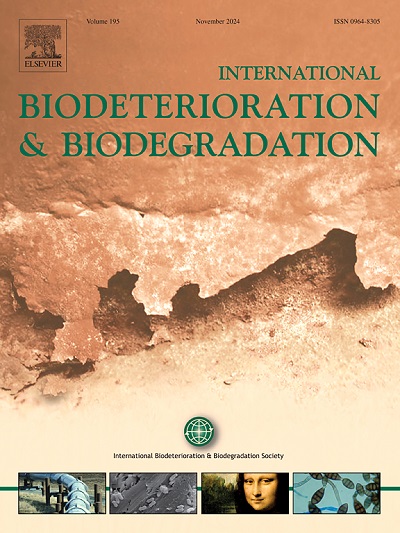Characteristic study of Pb2+ binding to extracellular polymeric substances from Staphylococcus epidermidis G257
IF 4.1
2区 环境科学与生态学
Q2 BIOTECHNOLOGY & APPLIED MICROBIOLOGY
International Biodeterioration & Biodegradation
Pub Date : 2025-02-01
DOI:10.1016/j.ibiod.2025.106004
引用次数: 0
Abstract
As an important toxic pollutant, lead (Pb2+) seriously threatens the environment and human well-being. Microbes and microbial extracellular polymeric substances (EPS) are highly effective at removing heavy metals from solutions. Herein, a Pb2+-tolerant strain, Staphylococcus epidermidis G257 was isolated from Guangxi of China. The strain showed strong resistance to Pb2+ and great Pb2+ adsorbability. The biosorption processes of S. epidermidis G257 and its EPS were characterized using microscopical techniques, ICP-MS, zeta potential measurement, XRD, FTIR, 3D-EEM, and XPS spectroscopy. Results showed that S. epidermidis G257 were effective in adsorbing Pb2+, with a biosorption efficiency of 81%. The biosorption process of Pb2+ was described well by the pseudo-second-order model with an adsorption capacity of 53.52 mg/g. Microscopical analyses showed that Pb2+ was adsorbed on the S. epidermidis surface by forming EPS precipitates. The variations in zeta potential indicated an electrostatic attraction in the Pb2+ adsorption process. Moreover, FTIR, 3D-EEM and XPS analyses revealed that the functional groups participating in Pb2+ adsorption were primarily carbonyl, carboxyl and amino groups of proteins in the EPS, which greatly facilitated Pb2+ adsorption by forming EPS-metal complexes. Therefore, this study unveiled that S. epidermidis G257 can be utilized as a potential biosorbent for eliminating Pb2+ from polluted environment.

Pb2+与表皮葡萄球菌G257胞外聚合物结合特性的研究
铅(Pb2+)作为一种重要的有毒污染物,严重威胁着环境和人类的健康。微生物和微生物胞外聚合物(EPS)在去除溶液中的重金属方面非常有效。本文从广西分离到一株耐Pb2+的表皮葡萄球菌G257。菌株对Pb2+具有较强的抗性和较强的吸附能力。采用显微技术、ICP-MS、zeta电位测量、XRD、FTIR、3D-EEM和XPS光谱对表皮葡萄球菌G257及其EPS的吸附过程进行了表征。结果表明,表皮葡萄球菌G257对Pb2+有较好的吸附效果,生物吸附效率为81%。吸附量为53.52 mg/g的准二级吸附模型较好地描述了Pb2+的生物吸附过程。显微分析表明,Pb2+通过形成EPS沉淀物吸附在表皮葡萄球菌表面。zeta电位的变化表明在Pb2+吸附过程中存在静电吸引。FTIR、3D-EEM和XPS分析表明,EPS中参与Pb2+吸附的官能团主要是蛋白质的羰基、羧基和氨基,这些官能团通过形成EPS-金属配合物,极大地促进了Pb2+的吸附。因此,本研究揭示了表皮葡萄球菌G257可以作为一种潜在的生物吸附剂用于去除污染环境中的Pb2+。
本文章由计算机程序翻译,如有差异,请以英文原文为准。
求助全文
约1分钟内获得全文
求助全文
来源期刊
CiteScore
9.60
自引率
10.40%
发文量
107
审稿时长
21 days
期刊介绍:
International Biodeterioration and Biodegradation publishes original research papers and reviews on the biological causes of deterioration or degradation.

 求助内容:
求助内容: 应助结果提醒方式:
应助结果提醒方式:


